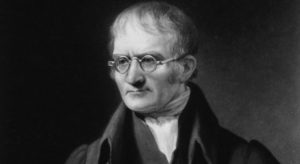
John Dalton (1766 – 1844) was an Englishman born into a relatively poor Quaker family but due to his high intelligence and persistent curiosity he grew to make many important contributions to science in meteorology, chemistry, and physics. He is remembered most for integrating atomic theory with chemistry.
Dalton embodied the Quaker way of life, living a humble life, never marring and never having any children. He was content with teaching, lecturing, and doing his research. In 1794 he wrote his first scientific paper on color blindness, concluding that color blindness was hereditary. Both he and his brother were color-blind. Although the specifics of his theory turned out to be incorrect, color blindness was termed Daltonism as a result of his work.
In the early 1800s Dalton formulated his atomic theory, although how he developed his ideas are not fully known. But he did have a lifelong interest in meteorology and recorded over 200,000 observations in his diary. He realized that evaporated water was independent or air, that they were each made of discrete particles, and that they mixed and occupied the same space. Through that he conducted various other experiments on the other known elements of the time – hydrogen, carbon, sulfur, and more – in an attempt to determine their relative sizes and weights. He was thus able to formulate a complete atomic theory, although naturally some of his ideas turned out to be incorrect.
Dalton’s atomic theory states that elements are made of vanishingly small, fundamental particles called atoms. These particles contain the same properties for each element but are different for different elements. Chemical reactions occur when atoms from different elements are combined or separated.
In 1822 the Royal Society elected him as a member; eleven years later the French Academy of Sciences elected his as a foreign member. Eleven years after that, in 1844 Dalton died of paralysis. His ideas lived on laying the framework of atomic theory for future scientists to improve upon and thrust the atomic idea to the forefront of the physical sciences.
works of art.